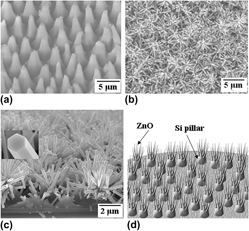Article contents
Structural and multiband photoluminescent properties of a hierarchical ZnO/Si nanoheterostructure
Published online by Cambridge University Press: 26 April 2011
Abstract

Hierarchical ZnO/Si nanoheterostructure was prepared by growing oriented ZnO nanowire bundles onto the top of nanoporous silicon pillar array (NSPA) via a self-catalytic thermal evaporation and vapor-phase transport method. Samples were carefully characterized using field emission scanning electron microscopy, x-ray diffraction, and luminescence spectroscopy. One ultraviolet, one blue-green, and two red emission bands were observed in ZnO/NSPA, and the emission mechanism is discussed by developing a model-based energy band diagram. The origins of the ultraviolet and blue-green photoluminescence (PL) bands were attributed to the emission from the band edge transition and surface states of oxygen vacancies of ZnO, while two red PL bands originated from NSPA and could be well explained by the quantum confinement-luminescence center model. The realization of such all solid and wide wavelength nanodevice might be both meaningful for developing new concept lighting devices and potentially extended to fabricate hierarchical Si-based nanoheterostructures in fabricating other optoelectronic nanodevices.
- Type
- Articles
- Information
- Copyright
- Copyright © Materials Research Society 2011
References
REFERENCES
- 3
- Cited by


